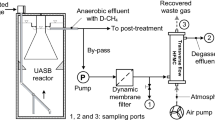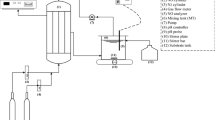Abstract
Bubbleless gas transfer through a hollow fiber membrane (HFM) module was used to supply H2 to an anaerobic reactor for in situ biogas upgrading, and it creates a novel system that could achieve a CH4 content higher than 90 % in the biogas. The increase of CH4 content and pH, and the decrease of bicarbonate concentration were related with the increase of the H2 flow rate. The CH4 content increased from 78.4 % to 90.2 % with the increase of the H2 flow rate from 930 to 1,440 ml/(l day), while the pH in the reactor remained below 8.0. An even higher CH4 content (96.1 %) was achieved when the H2 flow rate was increased to 1,760 ml/(l day); however, the pH increased to around 8.3 due to bicarbonate consumption which hampered the anaerobic process. The biofilm formed on the HFM was found not to be beneficial for the process since it increased the resistance of H2 diffusion to the liquid. The study also demonstrated that the biofilm formed on the membrane only contributed 22–36 % to the H2 consumption, while most of the H2 was consumed by the microorganisms in the liquid phase.


Similar content being viewed by others
References
Angelidaki I, Ellegaard L (2003) Codigestion of manure and organic wastes in centralized biogas plants — status and future trends. Appl Biochem Biotechnol 109(1–3):95–105
Angelidaki I, Sanders W (2004) Assessment of the anaerobic biodegradability of macropollutants. Rev Environ Sci Technol 3(2):117–129
APHA (1995) Standard methods for the examination of water and wastewater, 19, thth edn. American Public Health Association, New York, USA
Celmer D, Oleszkiewicz JA, Cicek N (2008) Impact of shear force on the biofilm structure and performance of a membrane biofilm reactor for tertiary hydrogen-driven denitrification of municipal wastewater. Water Res 42(12):3057–3065
Conklin A, Bucher R, Stensel HD, Ferguson J (2007) Effects of oxygen exposure on anaerobic digester sludge. Water Environ Res 79(4):396–405
Holm-Nielsen JB, Al Seadi T, Oleskowicz-Popiel P (2009) The future of anaerobic digestion and biogas utilization. Bioresour Technol 100(22):5478–5484
Kaparaju P, Buendia I, Ellegaard L, Angelidakia I (2008) Effects of mixing on methane production during thermophilic anaerobic digestion of manure: lab-scale and pilot-scale studies. Bioresour Technol 99(11):4919–4928
Lindberg A, Rasmuson AC (2006) Selective desorption of carbon dioxide from sewage sludge for in situ methane enrichment — Part 1. Pilot-plant experiments. Biotechnol Bioeng 95(5):794–803
Lindeboom R, Weijma J, van Lier J (2012) High-calorific biogas production by selective CO2 retention at autogenerated biogas pressures up to 20 bar. Environ Sci Technol 46(3):1895–1902
Liu Y, Tay JH (2002) The essential role of hydrodynamic shear force in the formation of biofilm and granular sludge. Water Res 36(7):1653–1665
Luo G, Angelidaki I (2013) Co-digestion of manure and whey for in situ biogas upgrading by the addition of H2: process performance and microbial insights. Appl Microbiol Biotechnol 97(3):1373–1381
Luo G, Karakashev D, Xie L, Zhou Q, Angelidaki I (2011) Long-term effect of inoculum pretreatment on fermentative hydrogen production by repeated batch cultivations: homoacetogenesis and methanogenesis as competitors to hydrogen production. Biotechnol Bioeng 108(8):1816–1827
Nordberg A, Edstrom M, Uusi-Penttila M, Rasmuson AC (2012) Selective desorption of carbon dioxide from sewage sludge for in-situ methane enrichment: enrichment experiments in pilot scale. Biomass Bioenergy 37:196–204
O'Flaherty V, Mahony T, O'Kennedy R, Colleran E (1998) Effect of pH on growth kinetics and sulphide toxicity thresholds of a range of methanogenic, syntrophic and sulphate-reducing bacteria. Process Biochem 33(5):555–569
Pankhania M, Stephenson T, Semmens MJ (1994) Hollow-fiber bioreactor for waste-water treatment using bubbleless membrane aeration. Water Res 28(10):2233–2236
Pauss A, Andre G, Perrier M, Guiot SR (1990) Liquid-to-gas mass-transfer in anaerobic processses—inevitable transfer limitations of methane and hydrogen in the biomethanation process. Appl Environ Microbiol 56(6):1636–1644
Richards BK, Herndon FG, Jewell WJ, Cummings RJ, White TE (1994) In-situ methane enrichment in methanogenic energy crop digesters. Biomass Bioenergy 6(4):275–282
Sahinkaya E, Hasar H, Kaksonen AH, Rittmann BE (2011) Performance of a sulfide-oxidizing, sulfur-producing membrane biofilm reactor treating sulfide-containing bioreactor effluent. Environ Sci Technol 45(9):4080–4087
Snoeyink VL, Jenkins D (1980) Water chemistry. John Wiley & Sons, New York
Wang LK, Chen GJ, Han GH, Guo XQ, Guo TM (2003) Experimental study on the solubility of natural gas components in water with or without hydrate inhibitor. Fluid Phase Equilibria 207(1–2):143–154
Weiland P (2010) Biogas production: current state and perspectives. Appl Microbiol Biotechnol 85(4):849–860
Zhao HP, Van Ginkel S, Tang YN, Kang DW, Rittmann B, Krajmalnik-Brown R (2011) Interactions between perchlorate and nitrate reductions in the biofilm of a hydrogen-based membrane biofilm reactor. Environ Sci Technol 45(23):10155–10162
Acknowledgements
This study was funded by the individual postdoctoral grants from the Danish Council for Independent Research (12-126632), Hans Christian Ørsted Postdoc Program from Technical University of Denmark, and the InterReg IVA programme Biorefinery Øresund financed by EU. The authors thank Hector Garcia for technical assistance with the experiments.
Author information
Authors and Affiliations
Corresponding author
Electronic supplementary material
Below is the link to the electronic supplementary material.
ESM 1
(PDF 274 kb)
Rights and permissions
About this article
Cite this article
Luo, G., Angelidaki, I. Hollow fiber membrane based H2 diffusion for efficient in situ biogas upgrading in an anaerobic reactor. Appl Microbiol Biotechnol 97, 3739–3744 (2013). https://doi.org/10.1007/s00253-013-4811-3
Received:
Revised:
Accepted:
Published:
Issue Date:
DOI: https://doi.org/10.1007/s00253-013-4811-3




